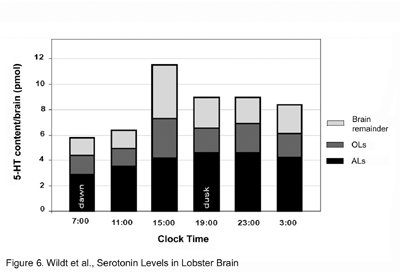Serotonin
In lobsters, as in vertebrates, the complete serotonergic system is composed of relatively few neurons that ramify extensively throughout the nervous system (Beltz and Kravitz, 1983; Beltz, 1999). Serotonin is first detectable immunocytochemically by 10% embryonic development (E10%) in fibers in the protocerebrum. The dorsal giant neurons (DGNs) are among the first somata to label for serotonin (by E40%; Beltz et al., 1992). Coincident with the appearance of serotonin in the fibers of the DGN, the accessory lobes emerge as small concentrations of neuropils just medial to the olfactory lobes. The coordinated appearance of serotonin in the DGNs and the first growth of the accessory lobes led to the hypothesis that serotonin might be involved in the assembly and/or growth of these neuropil regions. Therefore, to test whether serotonin promotes the growth or differentiation of its targets, we tested whether chronic serotonin depletion with the neurotoxin 5,7-dihydroxytryptamine (5,7-DHT) influenced the development of the lobster brain (Benton et al., 1997). This lovely study conducted by Jeannie Benton (with collaborators Robert Huber, Maureen Ruchhoeft and Simone Helluy) demonstrated that brains of juvenile lobsters depleted of serotonin are smaller and less well developed than control brains, and this finding set us onto the work that we have pursued since that time, trying to explain the causes of this retarded growth phenomenon. The DGNs, somewhat surprisingly, were not affected by serotonin depletion, but there were early clues that the cluster 10 projection neurons were influenced by these treatments. Jeremy Sullivan (Sullivan and Beltz, 2000) demonstrated that axonal outgrowth from cluster 10 neurons was inhibited in about 15% of these neurons. We also showed that neurogenesis among both the local (cluster 9) and projection (cluster 10) neurons was reduced after 5,7-DHT treatments (Benton and Beltz, 2001; Beltz et al., 2001). Further, when lobsters are treated with serotonin followed by BrdU, a small number of cells is double labeled for both 5HT and BrdU, suggesting that serotonin uptake may be a mechanism by which serotonin influences the newborn neurons (Beltz et al., 2001). Most recently, Miriam Wildt (Wildt et al., 2004) also showed that brain serotonin levels in juvenile lobsters are under circadian control, a finding that ties serotonin levels to circadian control of neurogenesis (Goergen et al., 2002).
|
Home | Links | Contact Us
- Maintained by: Barbara Beltz & Jeannie Benton
- Created: June 2, 2006
- Last Modified: June 2, 2006
- Expires: June 2, 2006

